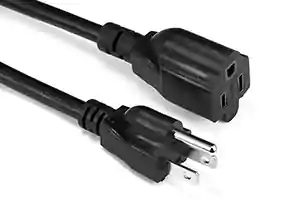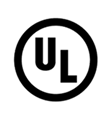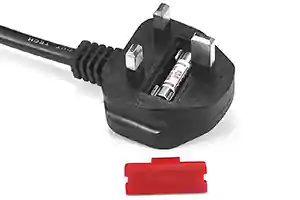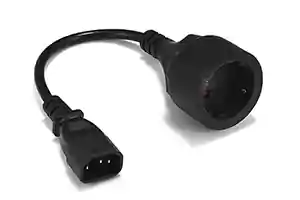The electricity Type D plug is also known as the Old British Plug. It has three large round pins in a triangular configuration and may be found in countries initially electrified by the British. It is almost exclusively used in India and Nepal.
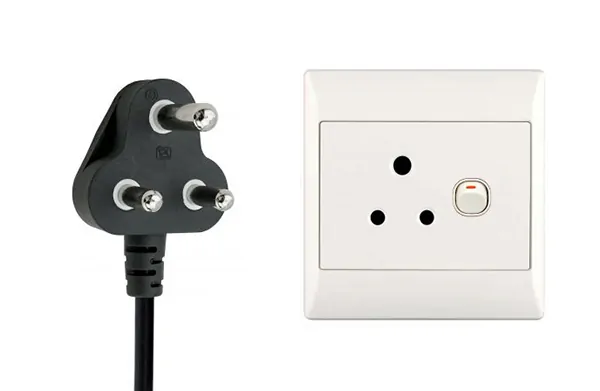
Table des matières
What is a Type D plug?
India has standardized on a power plug that was originally defined in British Standard 546 (the standard in Great Britain before 1947). Ce 5 amp plug has three round prongs that form a triangle. La broche de terre centrale est 20.6 mm de long et a un diamètre de 7.1 Applications de câbles de queue de cochon de prise d'alimentation mâle DC. La 5.1 la ligne mm et les broches neutres sont 14.9 mm de long, sur des centres espacés 19.1 mm de distance.
La distance centre à centre entre la broche de mise à la terre et le milieu de la ligne imaginaire reliant les deux broches d'alimentation est 22.2 Applications de câbles de queue de cochon de prise d'alimentation mâle DC. Tapez M, which has larger pins and is rated at 15 amplis, is used alongside type D for larger appliances in India, Népal, and Pakistan. Some sockets can take both type M and type D plugs.
There is unintended compatibility between type D sockets and various European plugs. Although the centers of the prongs of a Europlug (taper C) are closer together (17.5-18.6 mm vs. 19.1 Applications de câbles de queue de cochon de prise d'alimentation mâle DC) than those of a type D plug, a Euro plug often fits into a type D outlet without much effort, largely thanks to the elasticity of its pins.

Cependant, the power plug cannot be fully inserted into a D receptacle because the prongs are inelastic at the plug’s base, and they are longer than the pins of type D plugs (19 mm vs. 14.9 Applications de câbles de queue de cochon de prise d'alimentation mâle DC). This is the reason why type C plugs do not always make proper contact and may cause the socket to spark, which, in some cases, might result in a short-circuit.
Type D plug features
Whereas type C plugs and type D sockets could be considered an unsafe but ‘relatively workable’ combination, using E/F plugs with D outlets is downright dangerous. The centers of the pins of type E & F plugs are slightly closer together (19 mm vs. 19.1 Applications de câbles de queue de cochon de prise d'alimentation mâle DC) than those of type D, but unlike Euro plugs (taper C), they do not have flexible prongs. This means they have to be forced into the receptacle.
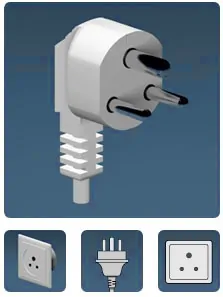
This kind of improper use poses an enormous safety hazard for some reasons. Firstly – unlike type C – E & F plugs are supposed to be grounded, but when they are used with type D outlets, this won’t be the case. Alors, be prepared for a sparking receptacle and a regularly tripping circuit breaker.
Moreover, type E and F plugs cannot be fully inserted into a D socket because the pins are longer than the pins of the Type D plug (19 mm vs. 14.9 Applications de câbles de queue de cochon de prise d'alimentation mâle DC). This means that 4.1 mm of the pins of plug types E & F will still be exposed when plugged in, and if you were to touch the live prong, you most certainly would get an electric shock. This risk does not exist with type C plugs since their pins are coated in insulation.
Although type D plug is now almost exclusively used in India and Nepal, it can still occasionally be found in hotels in the UK. It should be noted that tourists should not attempt to connect anything to a BS 546 round-pin outlet found in the UK as it is likely to be on a circuit that has a special purpose: par exemple., for providing direct current (CC) or for plugging in lamps that are controlled by a light switch or a dimmer.
Type D plugs are among the most dangerous ones in the world: les broches ne sont pas isolées (c'est à dire., les tiges des broches n'ont pas de revêtement noir vers le corps de la fiche comme le type C, g, je, L, ou N prises), which means that if a type D plug is pulled halfway out, ses broches sont toujours connectées à la prise! Les petits enfants risquent de s'électrocuter en débranchant une telle prise et en mettant leurs doigts autour. Type D outlets are not recessed into the wall, afin qu'ils ne protègent pas de toucher les broches sous tension.
What countries use Type D plug?
Afghanistan
Bengladesh
Bénin
Bostwana
Cameroun
Tchad
Dem. Rep. of Congo (Zaire)
Dominica
Ecuador
Le sauveur
Ethiopie
Guyane Française
Ghana
Grèce
Guadeloupe
Guyana
Hong Kong
Inde
Iraq
Jordan
Kenya
Lebanon
Libye
Macao
Madagascar
Maldives
Martinique
Monaco
Birmanie (Burma)
Namibie
Népal
Niger
Nigeria
Pakistan
Qatar
St. Kitts-Nevis
Sénégal
Sierra Leone
Sri Lanka
Sudan
Tanzania
Emirats Arabes Unis
Yemen
Zambia
Zimbabwe
What is the difference between Type D plug and Type M plug?
The Type D plug has three large round pins in a triangular pattern. Les prises de type M sont souvent utilisées avec les prises de type D pour les gros appareils, et comme résultat, certaines prises fonctionnent avec les fiches de type D et de type M.
La prise de type M a trois broches rondes dans un motif triangulaire et ressemble à la prise indienne de type D, mais ses broches sont beaucoup plus grandes. Les prises de type M sont parfois utilisées pour les appareils plus gros dans les pays qui utilisent des prises de type D et en Israël (Tapez H). Par conséquent, les prises de ces pays fonctionnent parfois avec des fiches de type M.
What plug type is used in South Africa?
For South Africa, there are four associated plug types, types C, ré, M, and N. Plug type C is the plug that has two round pins, type D plug is the plug which has three round pins in a triangular pattern, and plug types M and N both have three round pins. South Africa operates on a 230V supply voltage and 50Hz.
Maintenant ça’à votre tour
De sorte que’s how I understand Type D plug and socket.
Maintenant, je veux te céder la parole: A travers mon article, do you understand Type D Plugs and Sockets (Prises électriques)?
Do you have a different point of view with the power plug type D? Ou toute autre question?
Faites-le moi savoir en laissant un commentaire rapide ci-dessous dès maintenant.
